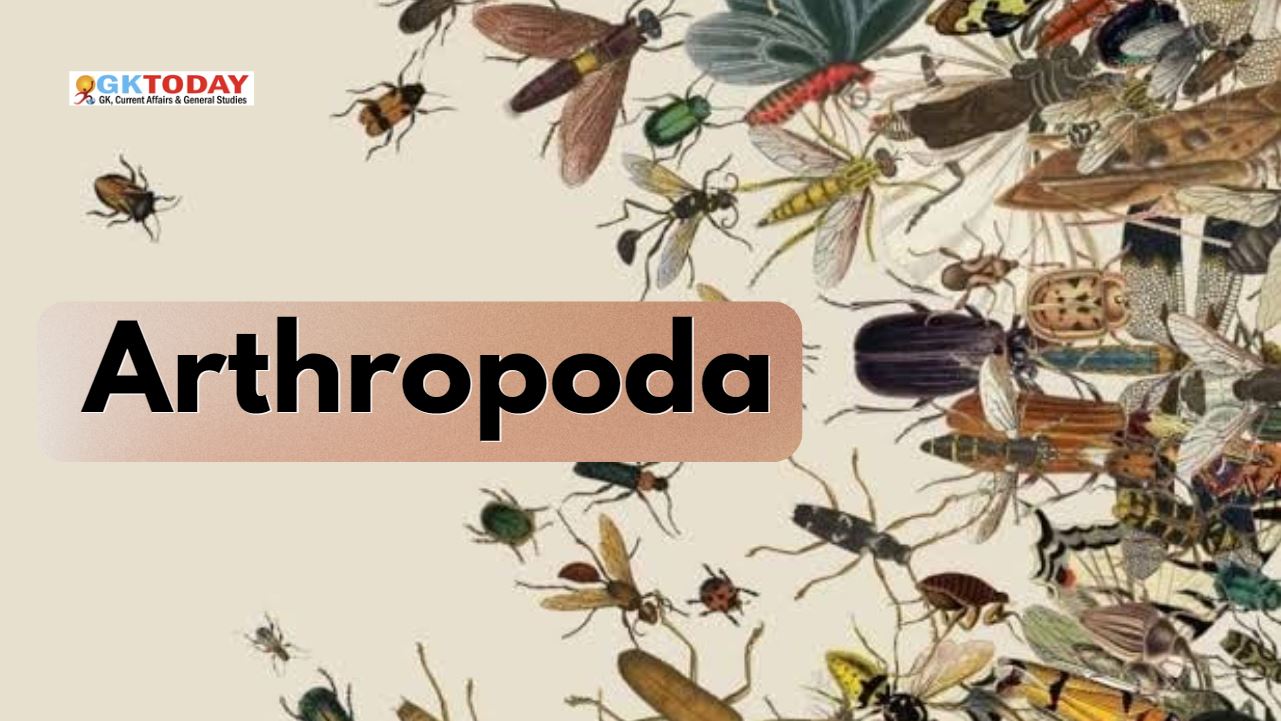Arthropoda
Arthropoda is the largest phylum of animal kingdom because around 2/3rd of all the named species on Earth belong to this phylum.
Ants, mosquitoes, flies, cockroaches, shrimp, crabs, spiders, scorpions etc. are examples of arthropods. There are three main classes of arthropods as follows:
- Insects: This includes mosquitoes, cockroaches, ants, flies, bees, moths, grasshoppers, beetles and butterflies
- Crustaceans: This includes crabs, lobsters, shrimp and barnacles
- Arachnids: This includes scorpions, spiders and mites
Further, a few other classes are onychophorans (velvet worms), diplopods (millipedes) and chilopods (centipedes).

Key features of Arthropods
Members of this phylum are invertebrates; have an exoskeleton made of chitin, segmented body and articulated (jointed) legs.
Molting in Arthropods
Due to the presence of the exoskeleton, the growth of arthropods is periodical. During the growth period, the animal loses the exoskeleton, grows and develops a new exoskeleton. This process is called ecdysis or molting. We note here that the in the exoskeleton of arthropods, there is a layer of waterproof wax. This feature was fundamental in allowing primitive arthropods from the sea to survive on dry land without losing excessive water to the environment.
Malpighian Tubules
Another key feature of Arthropoda is that the excretion in these animals takes place through so called Malpighian tubules.
Extracorporeal digestion
The Arachnids (scorpions, spiders and mites) inject poison to paralyze or kill their prey by using structures called chelicerae. The prey is partially digested outside the body of the arachnid by digestive enzymes injected together with the venom or afterwards. After this extracorporeal digestion, they eat and digest their prey.
Respiration
In Crustaceans (crabs, lobsters, shrimp and barnacles), gills are found for respiration. In terrestrial insects, respiration is tracheal whereby gases flow inside small tubes on animal’s external surface. Further, in arachnids (scorpions, spiders and mites) so called Book Lungs may also exist to aid in respiration.
Blood and Circulation
All arthropods have a heart. The respiratory system is open (lacunar). Blood, also known as hemolymph, is pumped by the heart and enters into cavities (lacunas), irrigating and draining tissues. In place of Haemoglobin, respiratory pigment called Haemocynanin is found in arthropods. We note here that although the circulatory system of insects works at a sluggish pace, they are ableto perform extremely fast and exhaustive movements because of separation of circulatory system from respiration. Gas exchange is carried out with great speed and efficiency by the tracheal system that puts cells in direct contact with air. Muscles can then work fast and hard.
Embryonic development
In crustaceans, some species undergo direct development whereas others undergo indirect development. In insects, some species do not have a larval stage, whereas others go through indirect development beginning with an egg stage followed by a nymph stage. Moreover, other insects go through indirect development beginning with a larval stage. The transformation of a larva into an adult insect is called metamorphosis.
Insects have two common types of metamorphosis.
- Grasshoppers, crickets, dragonflies, and cockroaches have incomplete metamorphosis. The young (called a nymph) usually look like small adults but without the wings.
- Butterflies, moths, beetles, flies and bees have complete metamorphosis. The young (called a larva instead of a nymph) is very different from the adults. It also usually eats different types of food. There are four stages in the metamorphosis of butterflies, moths and housefly viz. egg, larva, pupa, and adult.
In some insects such as butterflies and silk moth, larva makes a cocoon (chrysalis, pupa) where it lives until transforming into the adult form. The period during which the larva is within its cocoon is a time of intense biological activity since the larva is being transformed into an adult insect.
Main Differences between the Classes of Arthropods
- Wings are found only in Insects (mosquitoes, cockroaches, ants, flies, bees, beetles and butterflies). There are no wings in Crustaceans (crabs, lobsters, shrimp and barnacles) and Arachnids (scorpions, spiders and mites).
- Crustaceans have two pairs of antennae; insects have one pair; arachnids do not have antennae.
- In crustaceans and arachnids, the head is fused with the thorax to form the cephalothorax. Their body is therefore divided into cephalothorax and abdomen. Insects have a head, thorax and abdomen.
- Most crustaceans have five pairs of limbs. Insects have three pairs and arachnids have four pairs of limbs.


